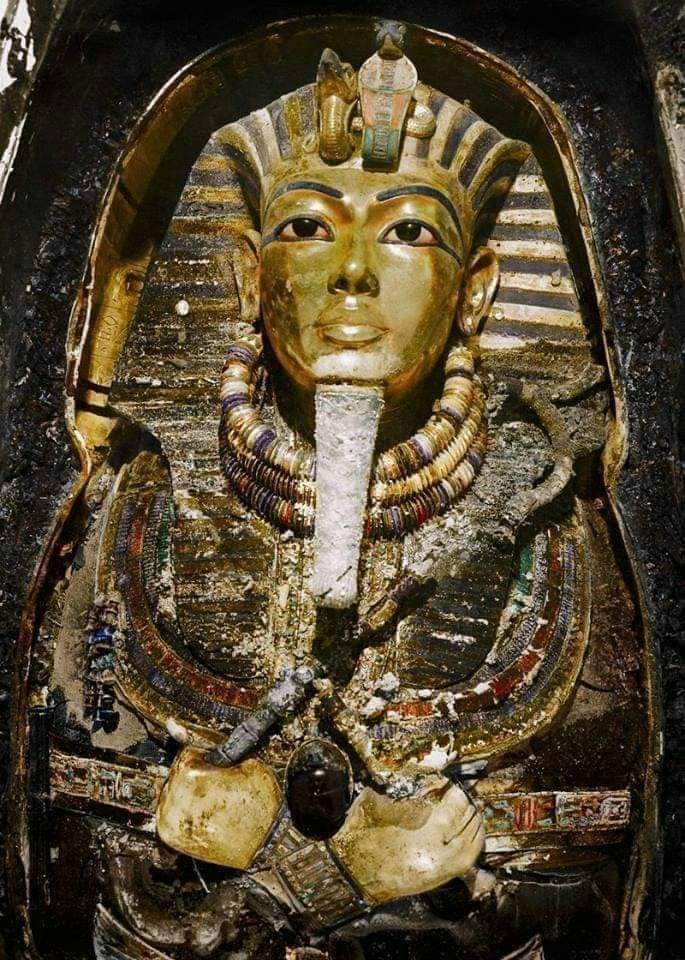The discovery of King Tutankhamun’s tomb in 1922 by British archaeologist Howard Carter stands as one of the most momentous events in archaeological history. Among the treasures unearthed in the tomb, the golden mask of the young pharaoh has emerged as an enduring emblem of ancient Egypt’s royal splendor. This iconic artifact, captured in the first photograph of the tomb, offers an extraordinary glimpse into the opulence and artistry of Egypt’s ancient civilization, captivating audiences worldwide and securing Tutankhamun’s place in history.
Hidden for over 3,000 years in the Valley of the Kings, King Tutankhamun’s tomb was an unprecedented archaeological find. Despite the brevity of his reign, the tomb contained over 5,000 meticulously crafted artifacts that shed light on Egypt’s royal and religious practices. The discovery, particularly of the golden mask, sparked a renewed fascination with Egyptology, transforming Tutankhamun into one of history’s most celebrated figures. This young pharaoh, whose reign lasted less than a decade, became a symbol of ancient Egypt’s enduring legacy.

The tomb’s treasures, ranging from intricately designed chariots to gilded furniture and exquisite jewelry, showcased the grandeur of ancient Egyptian culture. However, the golden mask stood out as the centerpiece of the discovery. This masterpiece, crafted from solid gold and adorned with semi-precious stones such as lapis lazuli, turquoise, and carnelian, symbolized the wealth, craftsmanship, and mystique of the New Kingdom. The mask’s intricate design and spiritual significance provided unparalleled insight into the artistic and religious values of ancient Egypt.
The golden mask is more than a testament to Egypt’s artistic achievements—it embodies the concept of divine kingship. The serene yet regal expression on the young pharaoh’s face, framed by the royal headdress, conveys a sense of authority and divinity. The mask features the cobra and vulture, symbols of Upper and Lower Egypt, representing Tutankhamun’s rule over a united kingdom. Its craftsmanship reflects the advanced skills of ancient Egyptian artisans, who used intricate inlay techniques and masterful metalworking to create a piece that remains unparalleled in its beauty and precision.
Beyond its artistic brilliance, the golden mask holds profound religious and spiritual significance. It was designed to protect Tutankhamun’s spirit and ensure his safe passage into the afterlife, reinforcing the pharaoh’s role as a divine intermediary between the gods and the people. The mask’s symbolism, materials, and craftsmanship reflect the spiritual beliefs of the time, emphasizing the pharaoh’s immortality and his connection to the divine.
Despite ascending the throne at the tender age of nine, Tutankhamun’s reign lasted only about ten years, ending with his untimely death at 18. Although his time as ruler was brief, the treasures within his tomb suggest that he played a significant role in Egypt’s religious and political landscape. His lavish burial, complete with provisions for the afterlife, underscores the importance of the pharaoh in ancient Egyptian society as both a temporal and spiritual leader.
The discovery of Tutankhamun’s tomb illuminated the significance of the New Kingdom period in ancient Egyptian history. This era, marked by remarkable cultural and artistic achievements, remains a focal point of Egyptology. The golden mask, along with the other treasures from the tomb, cemented Tutankhamun’s place in history, serving as a testament to the sophistication and grandeur of ancient Egyptian civilization.
The global fascination with King Tutankhamun can be attributed in part to the first photograph of his tomb, with the golden mask at its center. This image played a pivotal role in bringing the young pharaoh’s story to the world’s attention. The discovery ignited an unprecedented wave of interest in ancient Egypt, inspiring both public curiosity and academic research into Egyptian art, religion, and mummification practices. The treasures from the tomb, including the golden mask, have been meticulously preserved and displayed in museums, allowing millions of people worldwide to experience the splendor of Egypt’s royal heritage.
King Tutankhamun’s golden mask continues to captivate audiences, symbolizing the brilliance of the ancient world. It serves as a powerful representation of the continuity of kingship and the enduring cultural legacy of ancient Egypt. The mask’s timeless appeal lies not only in its artistic and historical significance but also in its ability to connect modern audiences with a civilization that flourished thousands of years ago.
The discovery of Tutankhamun’s tomb and the golden mask has left an indelible mark on both archaeology and popular culture. The artifacts provide invaluable insights into the lives, beliefs, and practices of ancient Egyptians, while the mask itself remains a symbol of the civilization’s artistic and spiritual achievements. For scholars and enthusiasts alike, King Tutankhamun’s tomb represents a treasure trove of knowledge, offering a window into the grandeur and mystery of one of history’s greatest civilizations.
In conclusion, King Tutankhamun’s golden mask, immortalized in the first photograph of his tomb, stands as one of the most iconic and awe-inspiring artifacts ever discovered. It embodies the majesty and mystery of ancient Egyptian royalty while highlighting the incredible accomplishments of one of the world’s oldest civilizations. The discovery of the tomb and its treasures continues to captivate the imagination, bridging the past and present, and offering a timeless connection to Egypt’s royal legacy. Through the golden mask and the wealth of artifacts unearthed from his tomb, King Tutankhamun remains a beacon of ancient Egypt’s cultural and artistic brilliance, inspiring awe and admiration to this day.





